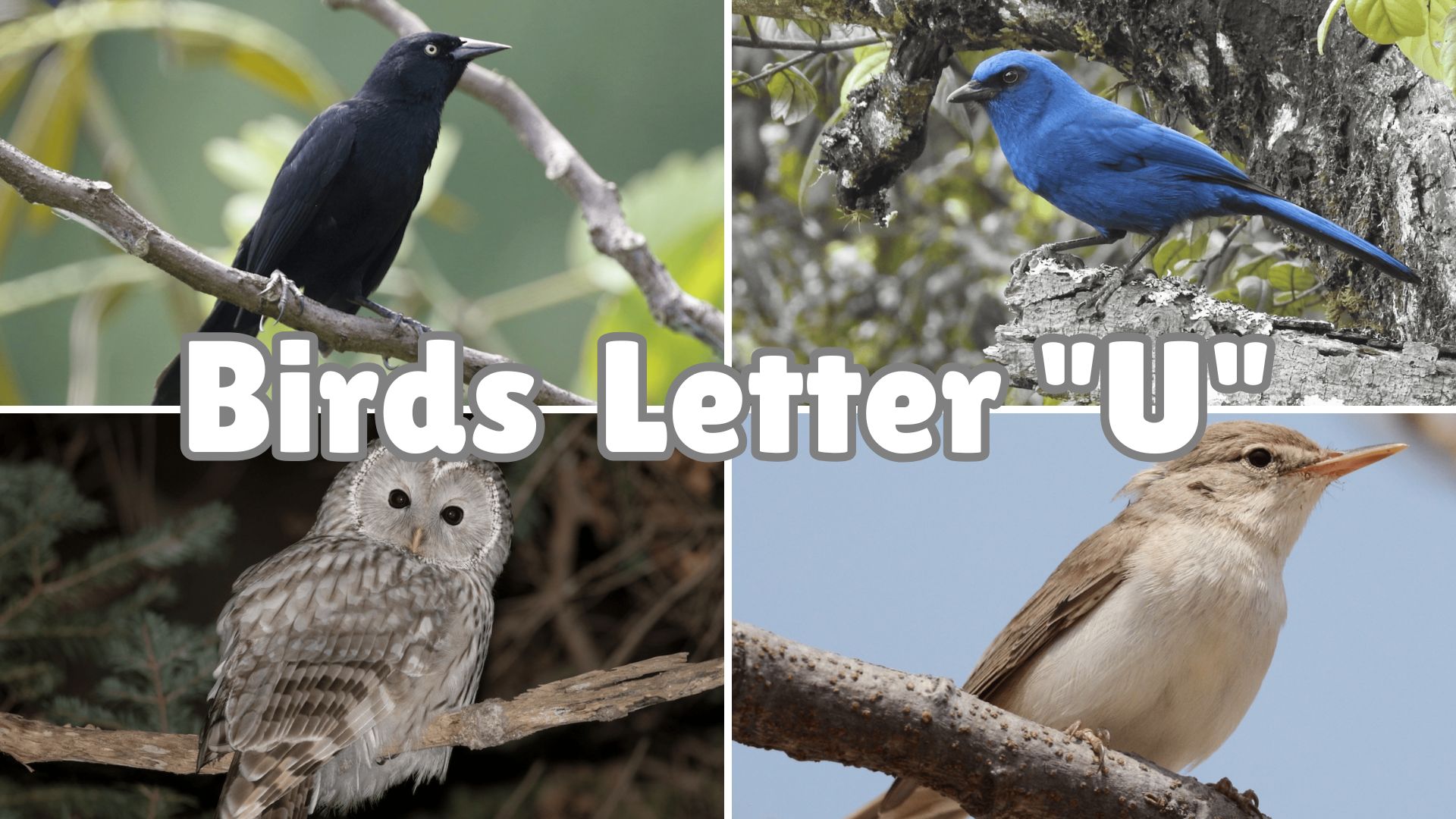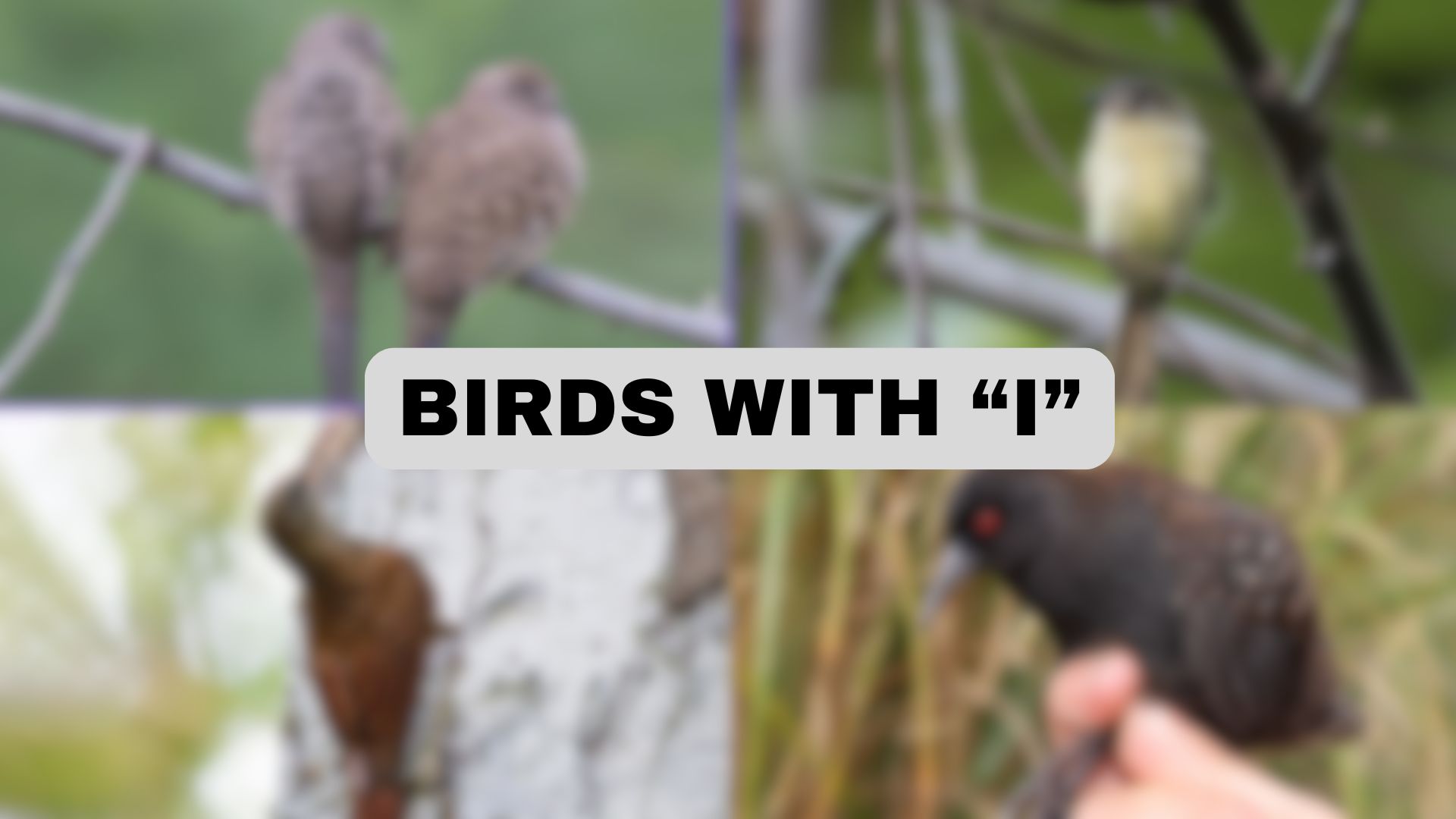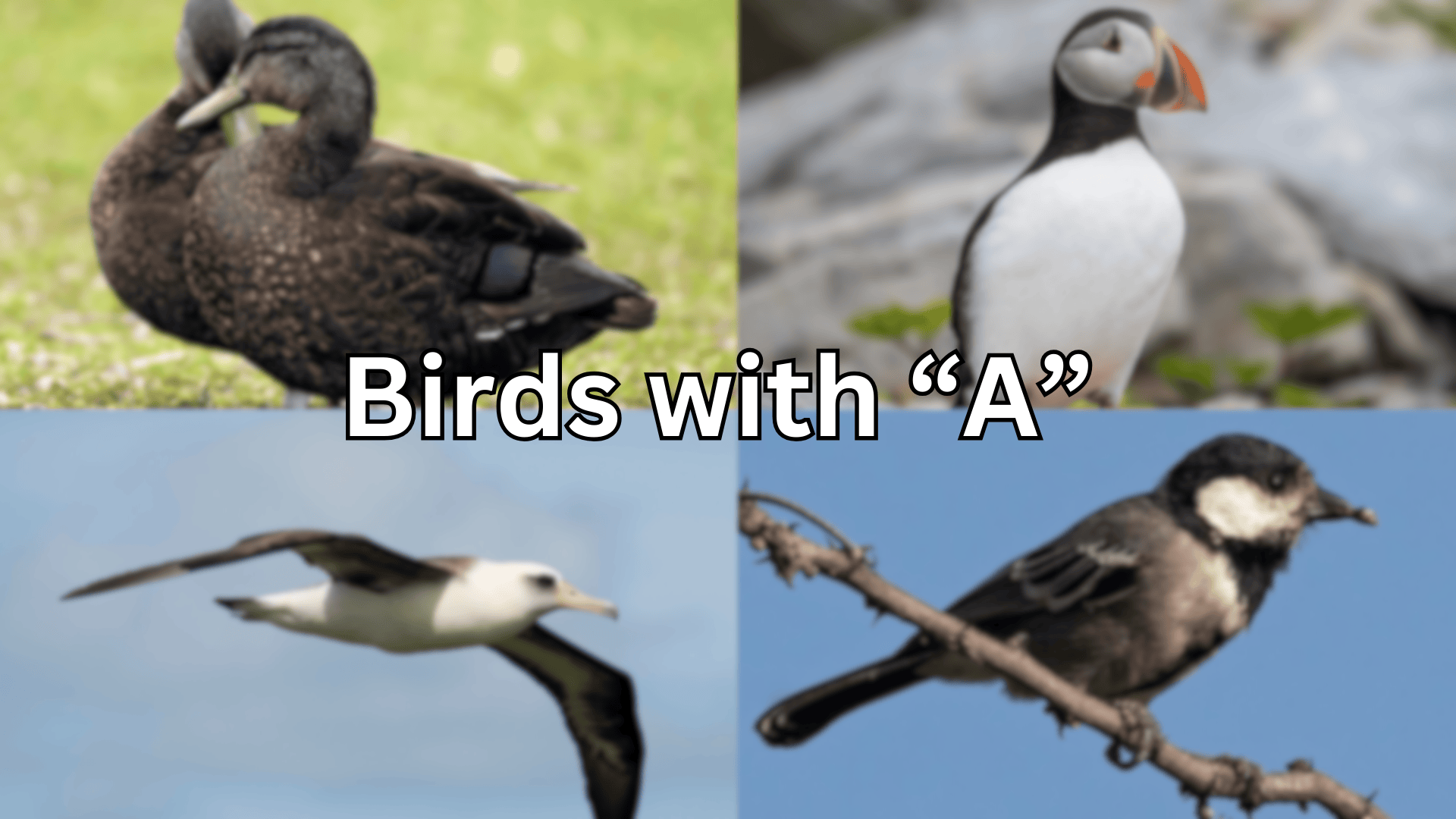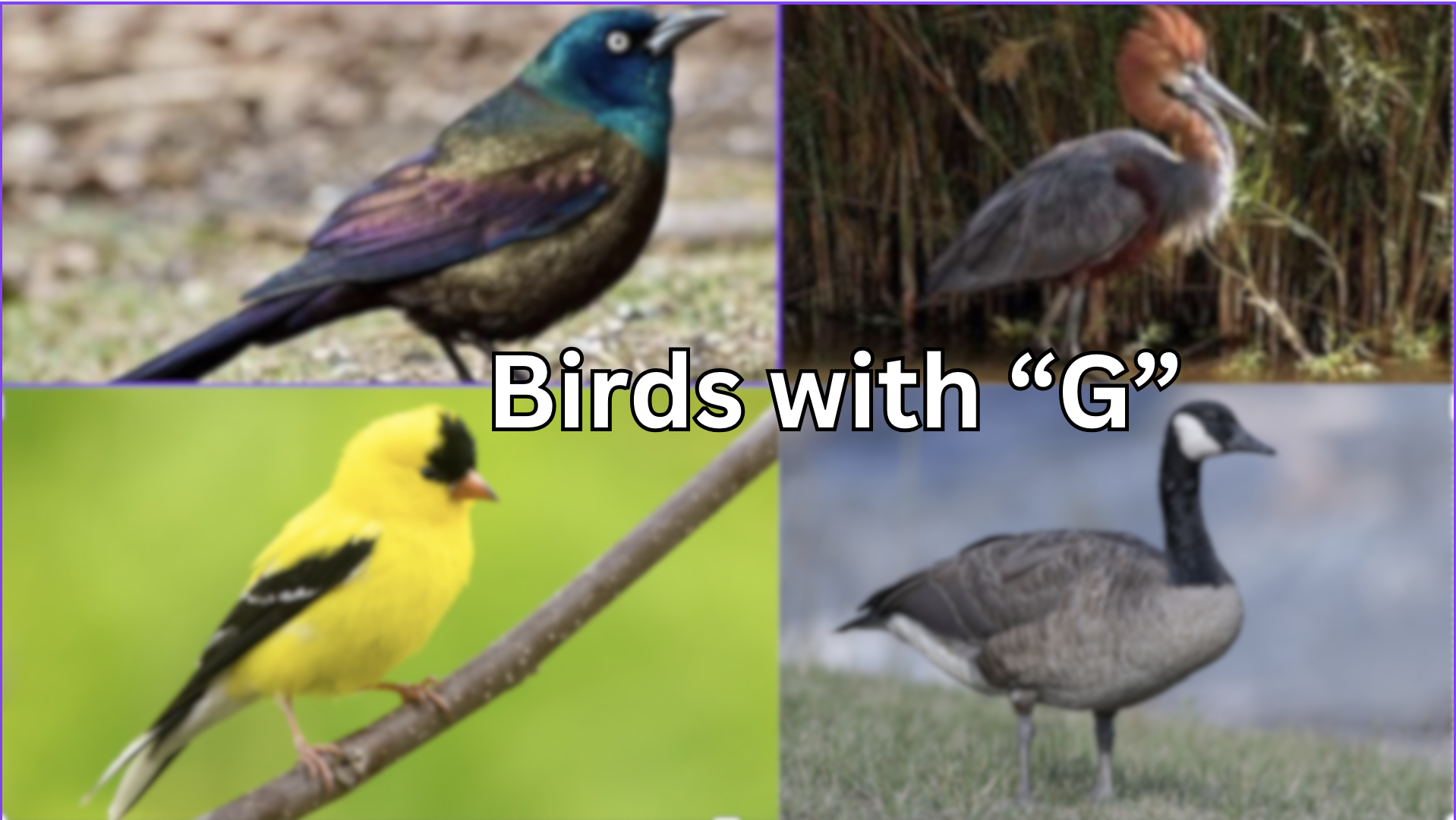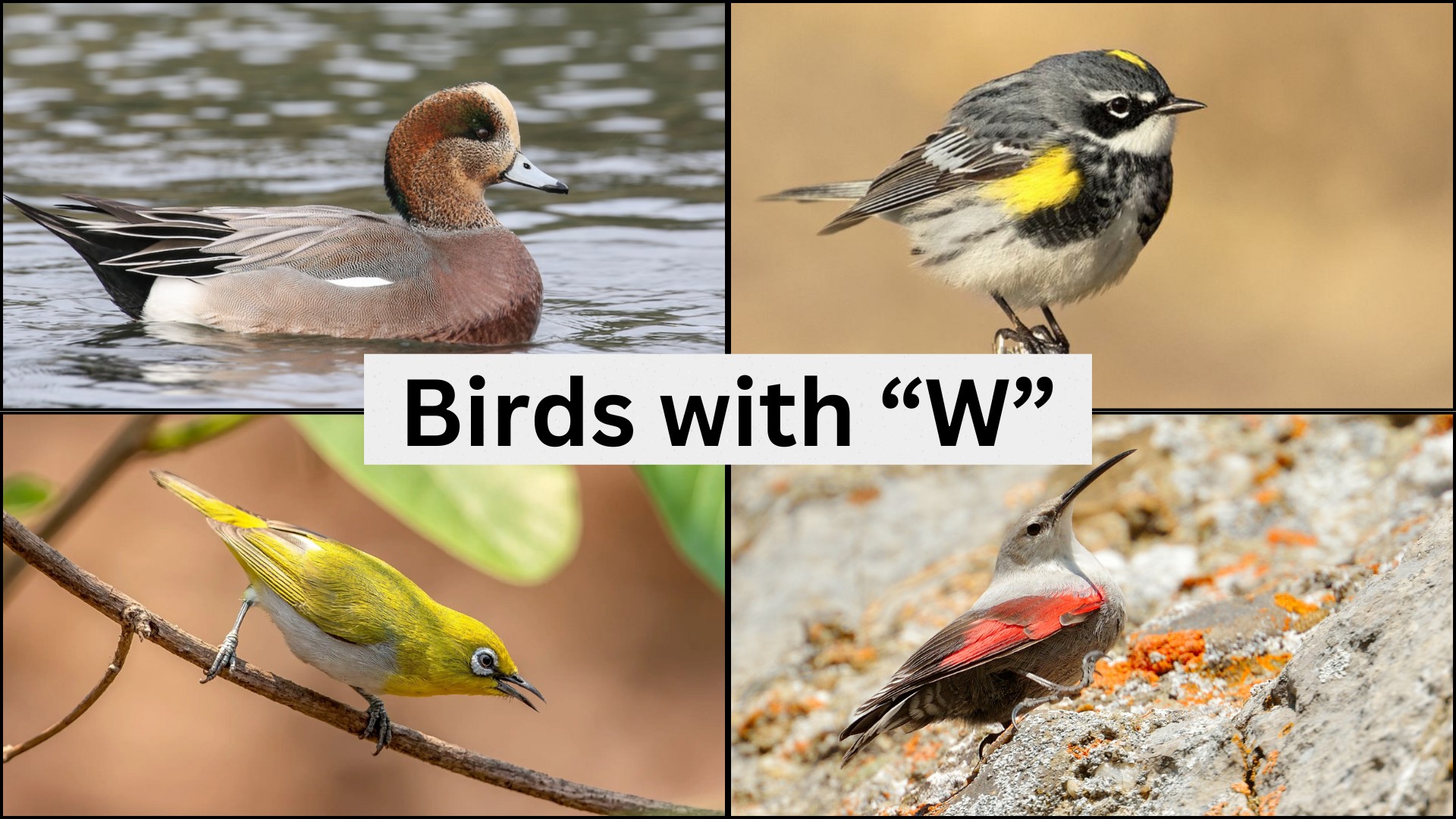
Take flight through the world of birds beginning with “T”, An expedition from the humble Tit to the dazzling Toucan charm.
Did you know that the Turkey Vulture has such a powerful sense of smell it can detect carrion from over a mile away?
In this detailed guide, we’ll explore the habitats, scientific names, diets, and unique calls of these magical birds that start with “T”.
Whether you’re a dedicated birdwatcher, a nature enthusiast, or simply curious about avian species, this blog has something for everyone.
From forest canopies to coastal shores, these birds demonstrate nature’s incredible adaptability and beauty. Get ready to learn about the terrific “T” birds that make our planet so wonderfully diverse!
Common Birds With the Letter “T”
1. Toco Toucan
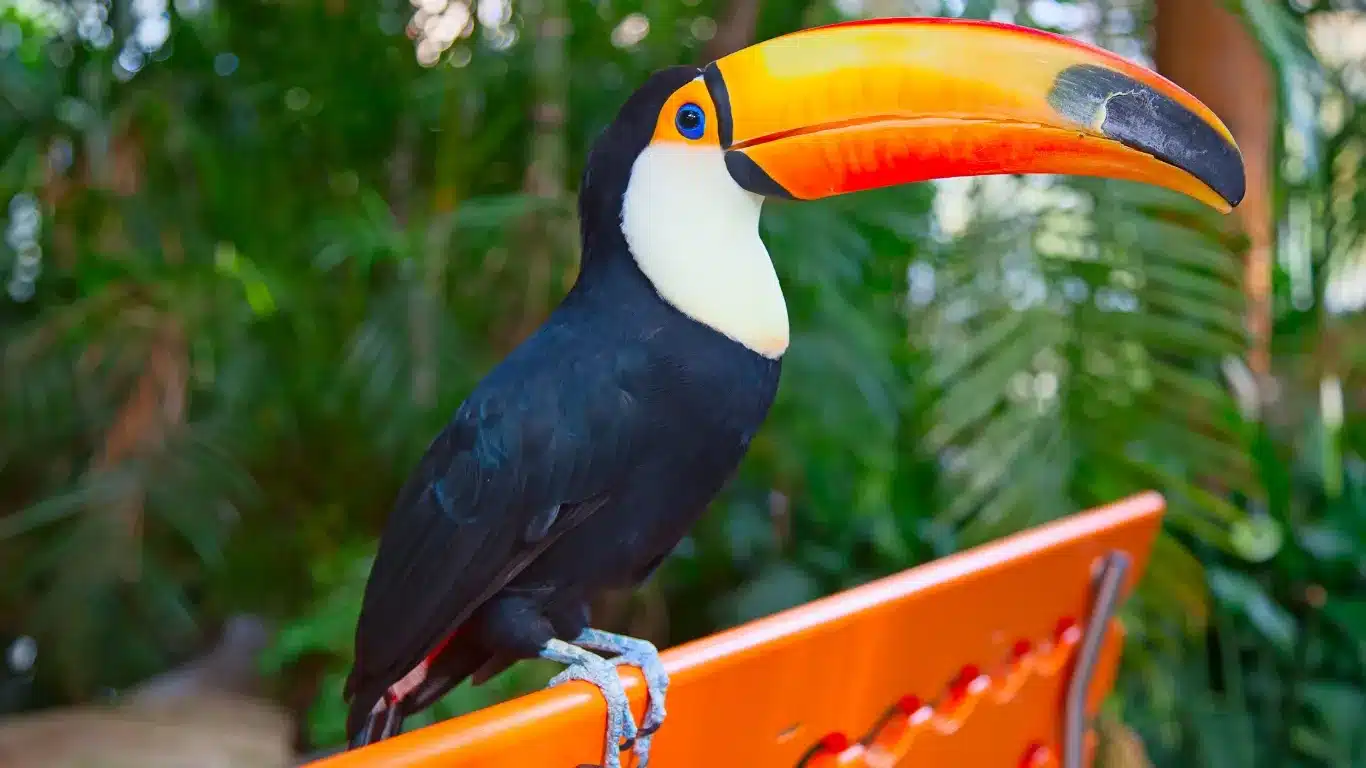
The Toco Toucan is the largest and most recognizable of all toucan species, with its oversized orange bill, black body, and white throat. It measures about 25 inches in length and weighs around 1.5 pounds.
Its bright bill is surprisingly lightweight and helps regulate body temperature.
- Region of Habitat: Found across tropical forests and savannas of central and eastern South America, particularly in Brazil, Paraguay, and northern Argentina.
- Scientific Name: Ramphastos toco
- Feeding Habits: Omnivorous; eats a variety of fruits, insects, small reptiles, and bird eggs. It uses its long bill to pluck fruit from trees and reach into nests.
- What Sound They Make: Produces deep, frog-like croaks and clattering bill sounds for territorial and social communication.
Fun Facts
Despite its huge bill, the Toco Toucan is a weak flyer and often hops between branches. Its bill also helps it stay cool by dispersing heat through blood flow near the surface.
2. Trumpeter Swan

The Trumpeter Swan is North America’s largest native waterfowl, boasting a wingspan up to 10 feet and weighing over 25 pounds. It has a pure white body, a long neck, and a distinctive black bill.
- Region of Habitat: Inhabits wetlands, lakes, and slow rivers in Alaska, Canada, and parts of the northern U.S. during breeding season, migrating slightly south in winter.
- Scientific Name: Cygnus buccinator
- Feeding Habits: Herbivorous; feeds on aquatic vegetation, roots, and tubers and occasionally grazes on land near water.
- What Sound They Make: Known for its loud, trumpet-like honking call, used for communication between mates and to establish territory.
Fun Facts
Trumpeter Swans form lifelong pair bonds and often return to the same nesting site each year. They were once near extinction but have made a major comeback due to conservation efforts.
3. Tawny Owl
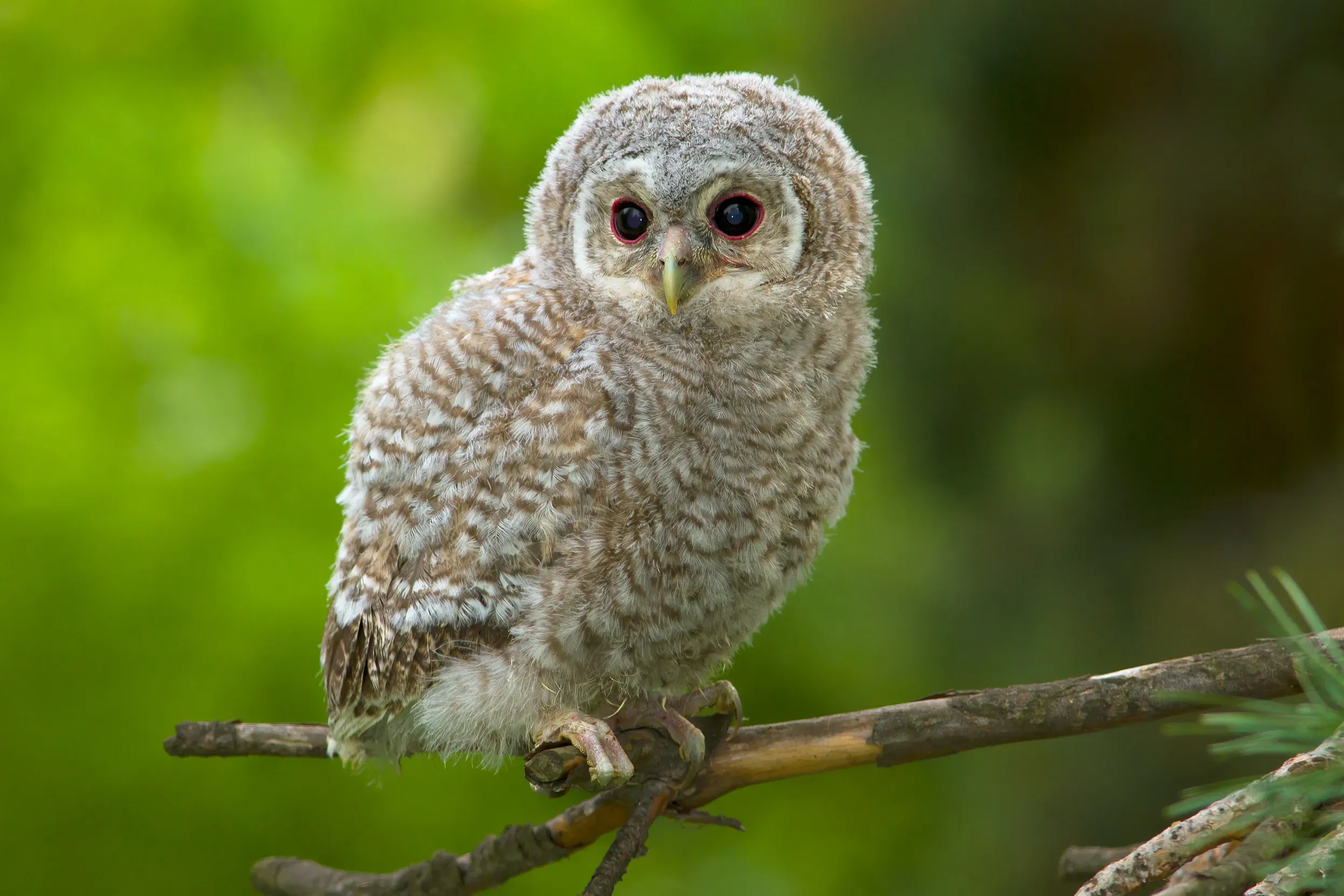
The Tawny Owl is a medium-sized, stocky owl with a rounded head and no ear tufts. It has a mottled brown and cream plumage that blends perfectly with tree bark, and large dark eyes adapted for night vision.
- Region of Habitat: Common throughout woodlands, parks, and even urban areas across Europe and parts of western Asia.
- Scientific Name: Strix aluco
- Feeding Habits: Carnivorous; preys on small mammals, birds, frogs, and insects, hunting mostly at night.
- What Sound They Make: Famous for their haunting “twit-twoo” hoot, which is actually a duet between male and female owls.
Fun Facts
Tawny Owls are fiercely territorial and often return to the same roosting site. Their vision is so sharp at night that they can detect prey in near-total darkness.
4. Tufted Puffin
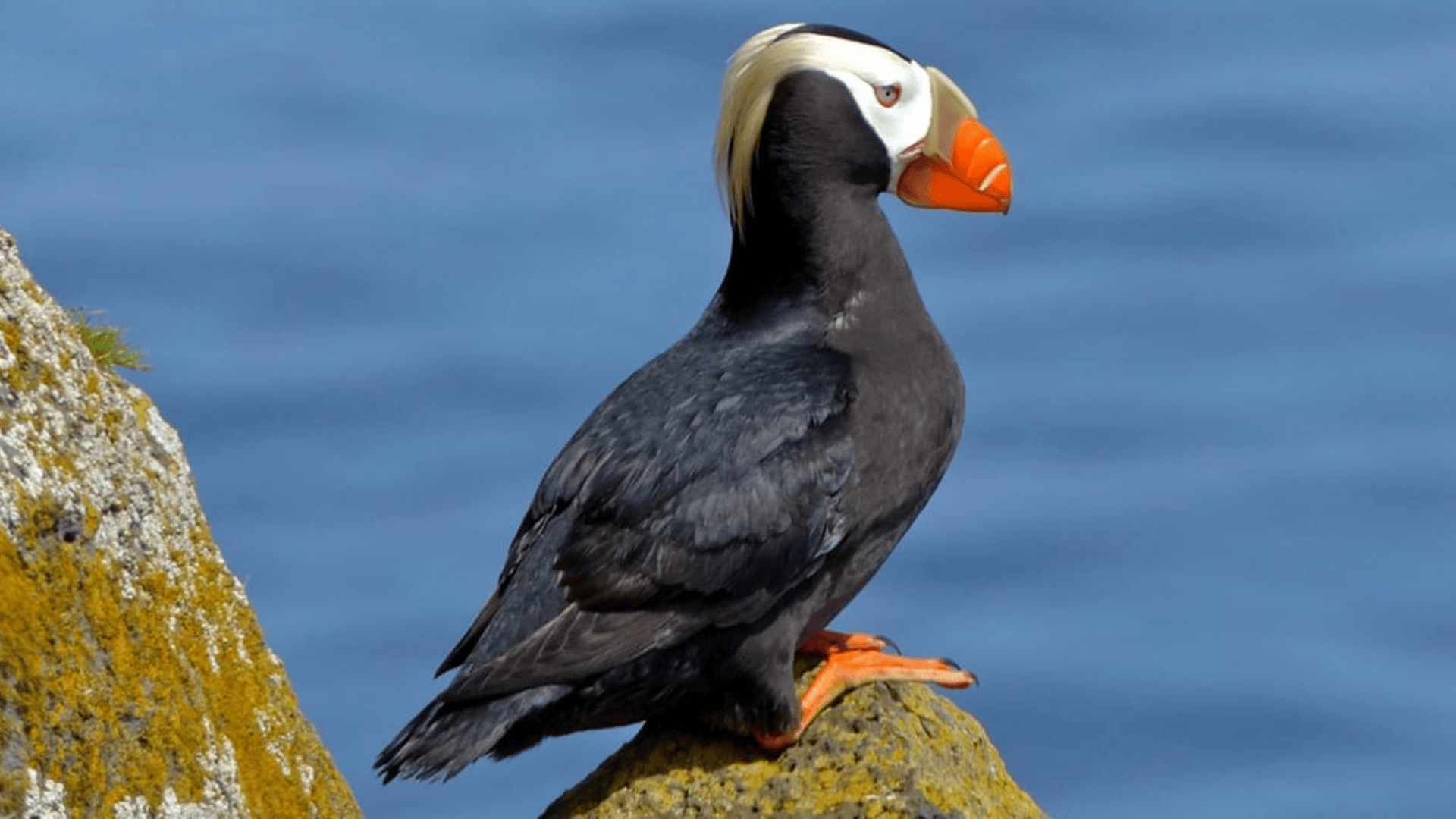
The Tufted Puffin is a striking seabird known for its thick orange bill and long, creamy tufts that droop from each side of its head during breeding season. It has a black body and white face and measures about 15 inches long.
- Region of Habitat: Found along the rocky coasts and islands of the North Pacific, from California to Japan, especially during breeding season.
- Scientific Name: Fratercula cirrhata
- Feeding Habits: Piscivorous; dives underwater to catch small fish like herring and sand lance, using its wings to swim.
- What Sound They Make: They emit low growls and groans when in breeding colonies, mostly silent while at sea.
Fun Facts
Tufted Puffins can carry multiple fish in their bills at once due to backward-facing spines on their tongue. They nest in deep burrows on cliff sides, often returning to the same spot yearly.
5. Tropical Kingbird
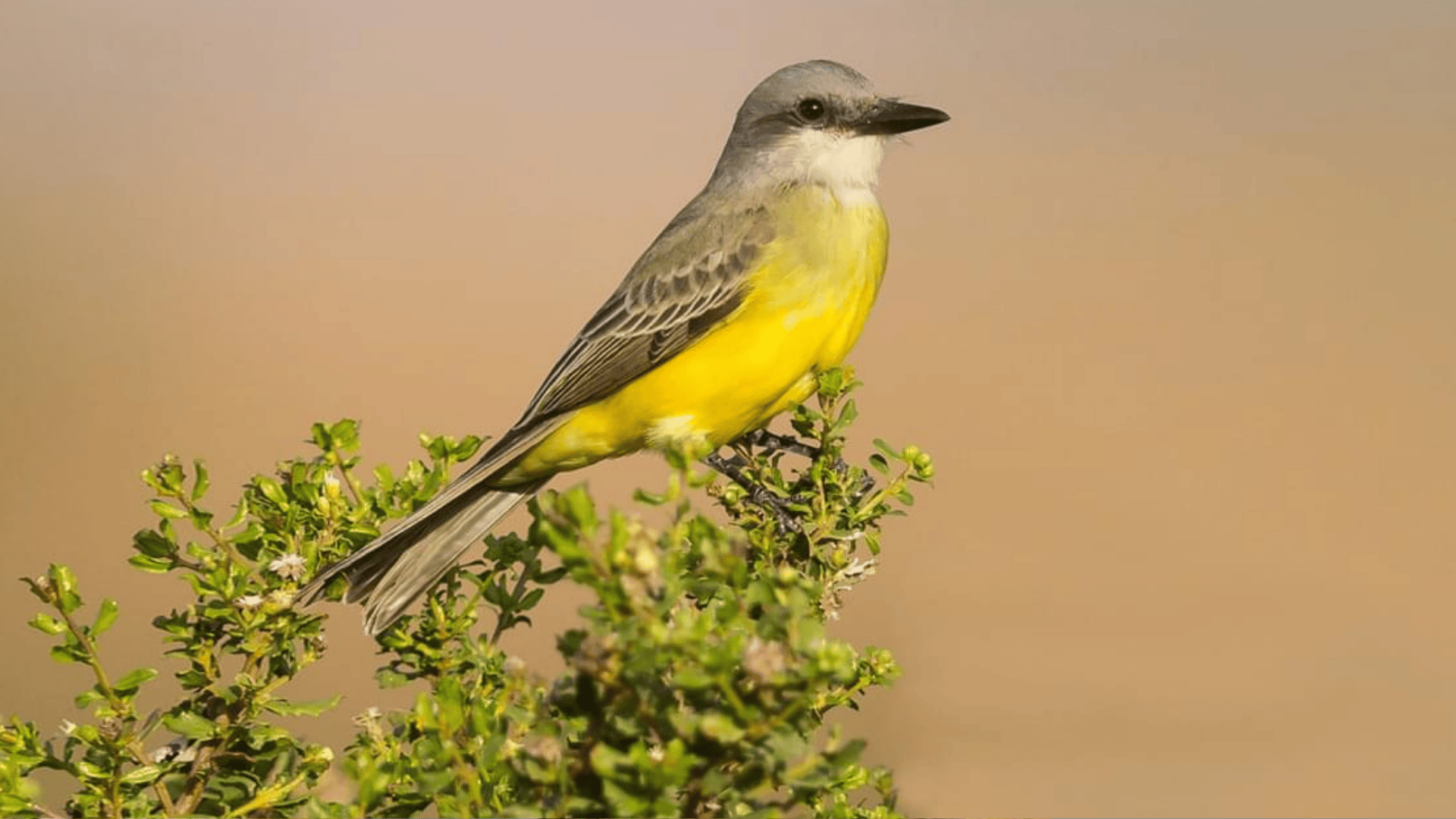
The Tropical Kingbird is a bold and energetic songbird with a gray head, olive-green back, and bright yellow belly. It has a medium-length tail and is known for aggressive aerial behavior while defending its territory.
- Region of Habitat: Widespread throughout Central and South America, as well as parts of the southern U.S., in open woodlands, savannas, and urban areas.
- Scientific Name: Tyrannus melancholicus
- Feeding Habits: Insectivorous; catches insects mid-air but also eats berries and small fruits during non-breeding seasons.
- What Sound They Make: Calls include a series of rapid, high-pitched “kip-kip-kip” notes and sharp trills used for mate and territory communication.
Fun Facts
Tropical Kingbirds are fearless defenders of their nests, often chasing off much larger birds like hawks. Seasonally, they migrate northward, reaching as far as Texas and Arizona.
6. Takahe
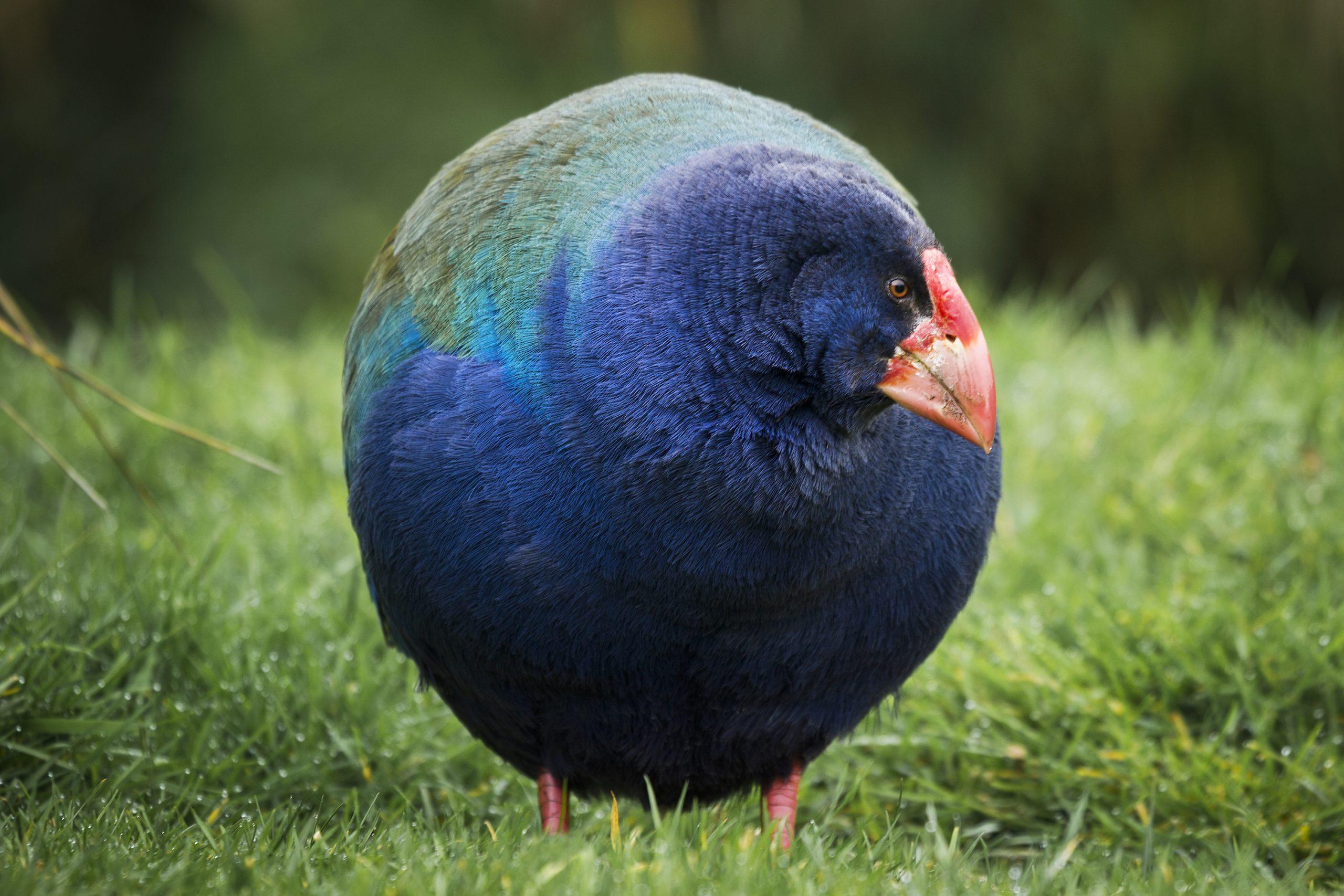
The Takahe is a large, flightless bird with striking blue and green plumage, a stout red beak, and strong legs. It can grow up to 25 inches tall and weigh nearly 7 pounds, giving it a robust and compact appearance.
- Region of Habitat: Endemic to New Zealand, mainly found in alpine grasslands and protected sanctuaries in Fiordland and surrounding regions.
- Scientific Name: Porphyrio hochstetteri
- Feeding Habits: Herbivorous; primarily eats tussock grasses, shoots, and other alpine vegetation. Uses its beak to strip leaves and dig for roots.
- What Sound They Make: They produce deep grunts and soft hoots for communication, especially during courtship or when alarmed.
Fun Facts
The Takahe was once thought to be extinct until it was rediscovered in 1948. It is one of the world’s rarest birds and is the subject of intensive conservation and breeding programs.
7. Tawny Eagle
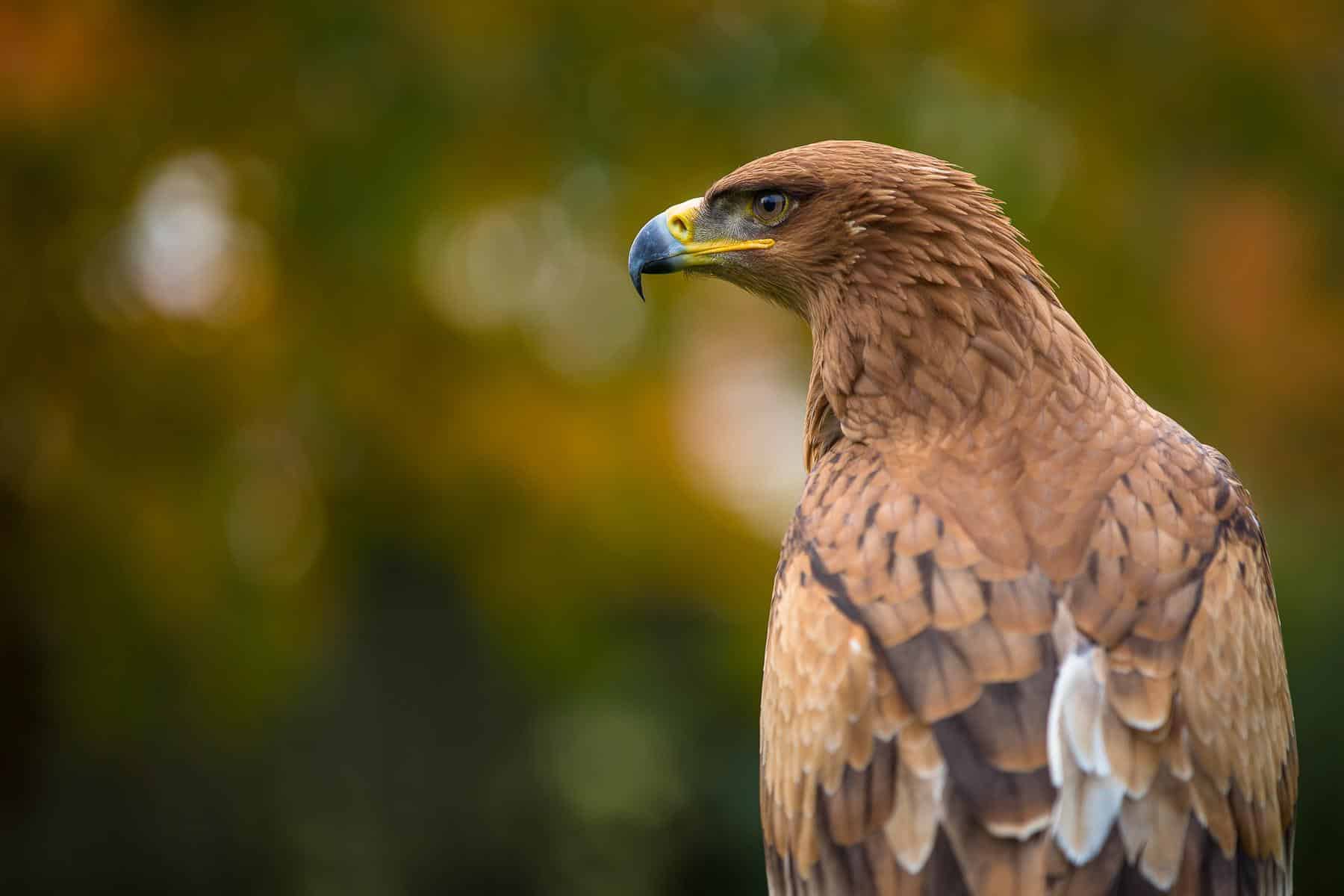
The Tawny Eagle is a large raptor with broad wings, a powerful hooked beak, and plumage that varies from light brown to dark tawny. Adults can measure about 26–30 inches in length with a wingspan over 6 feet.
- Region of Habitat: Found throughout Africa and parts of the Indian subcontinent, typically in open savannas, semi-deserts, and grasslands.
- Scientific Name: Aquila rapax
- Feeding Habits: Carnivorous; hunts small mammals, birds, reptiles, and carrion. Often seen scavenging near kills or roadside carcasses.
- What Sound They Make: They emit sharp, whistling cries, especially while in flight or near nests.
Fun Facts
Tawny Eagles are known to steal prey from other birds, including vultures. They are solitary hunters and build massive stick nests reuse year after year.
8. Toucan Barbet
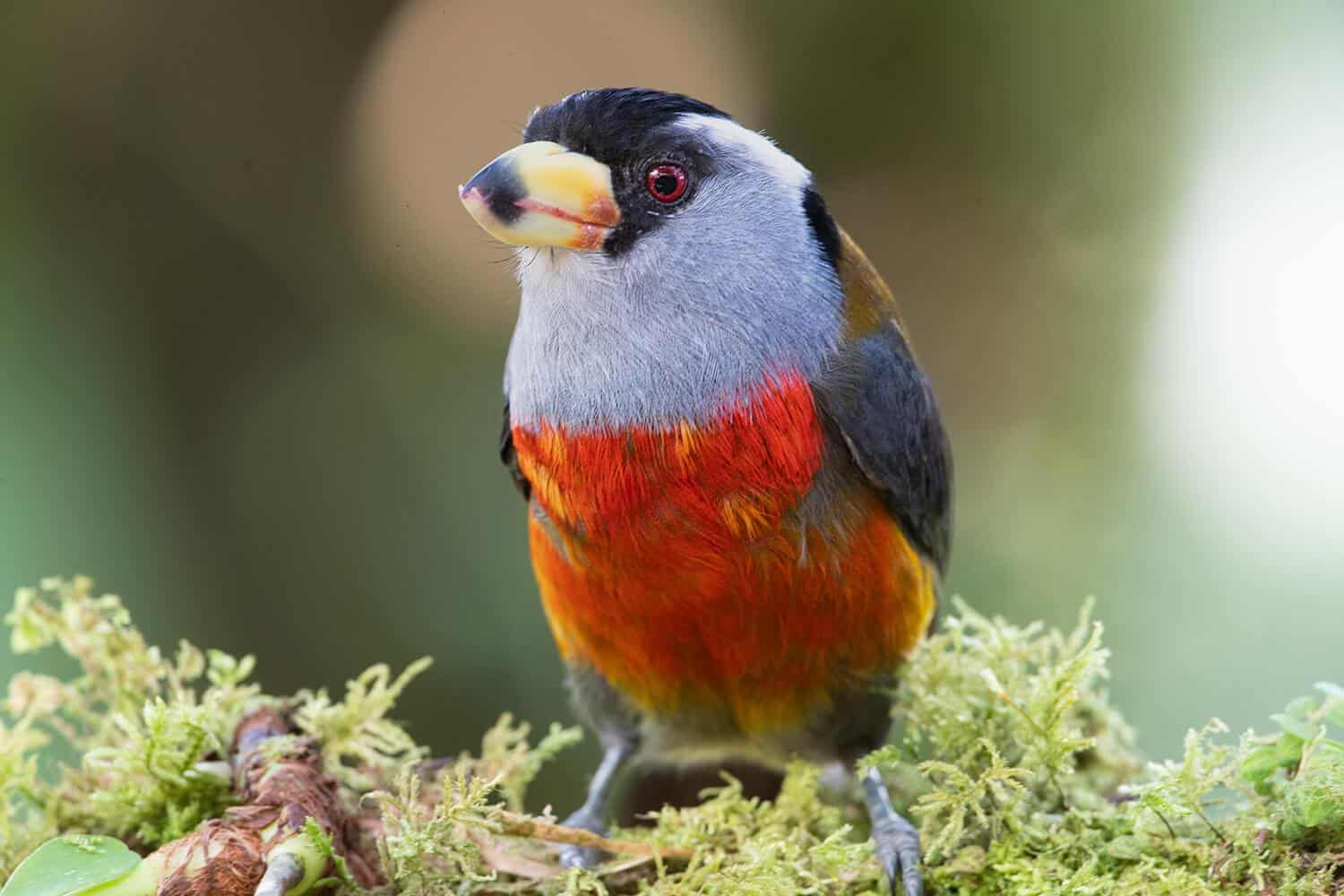
The Toucan Barbet is a vividly colored bird with a thick, parrot-like beak, and plumage featuring red, yellow, black, and blue. It measures around 8 inches long and has a chunky body typical of barbets.
- Region of Habitat: Inhabits cloud forests of western Colombia and Ecuador, often seen in mid-level to canopy forest zones.
- Scientific Name: Semnornis ramphastinus
- Feeding Habits: Frugivorous; feeds mainly on fruit, but also takes insects and small vertebrates. Plays a key role in seed dispersal.
- What Sound They Make: They deliver soft, whistled duets between pairs, often heard before the birds are seen.
Fun Facts
Despite their name, toucan barbets are more closely related to barbets than true toucans. Toucan Barbets are cooperative breeders, with older siblings helping raise the young.
9. Trumpeter Hornbill
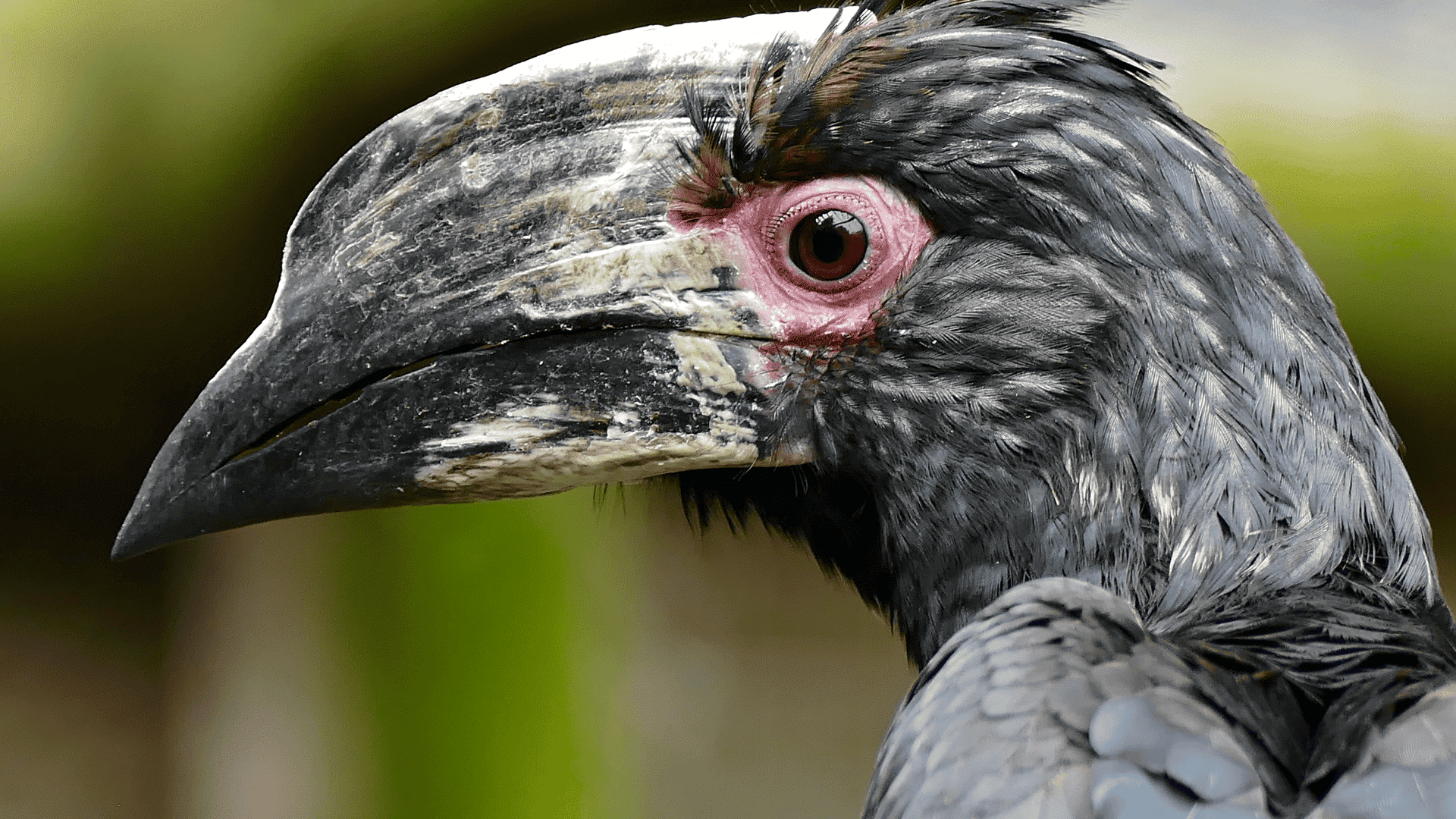
This medium-sized hornbill has a distinctive curved bill with a casque on top, a white belly, and glossy black plumage with white wing patches. It can reach about 24 inches in length and is agile in flight.
- Region of Habitat: Found in forests and woodlands of southern and eastern Africa, particularly near rivers and fig trees.
- Scientific Name: Bycanistes bucinator
- Feeding Habits: Frugivorous; primarily eats figs and other fruits, occasionally supplementing with insects and small animals.
- What Sound They Make: Named for its loud, trumpet-like call, which carries far through the forest canopy.
Fun Facts
During breeding, the female seals herself inside a tree cavity with mud, leaving only a small slit for the male to deliver food. Their loud calls help family groups stay connected in dense forests.
10. Townsend’s Warbler
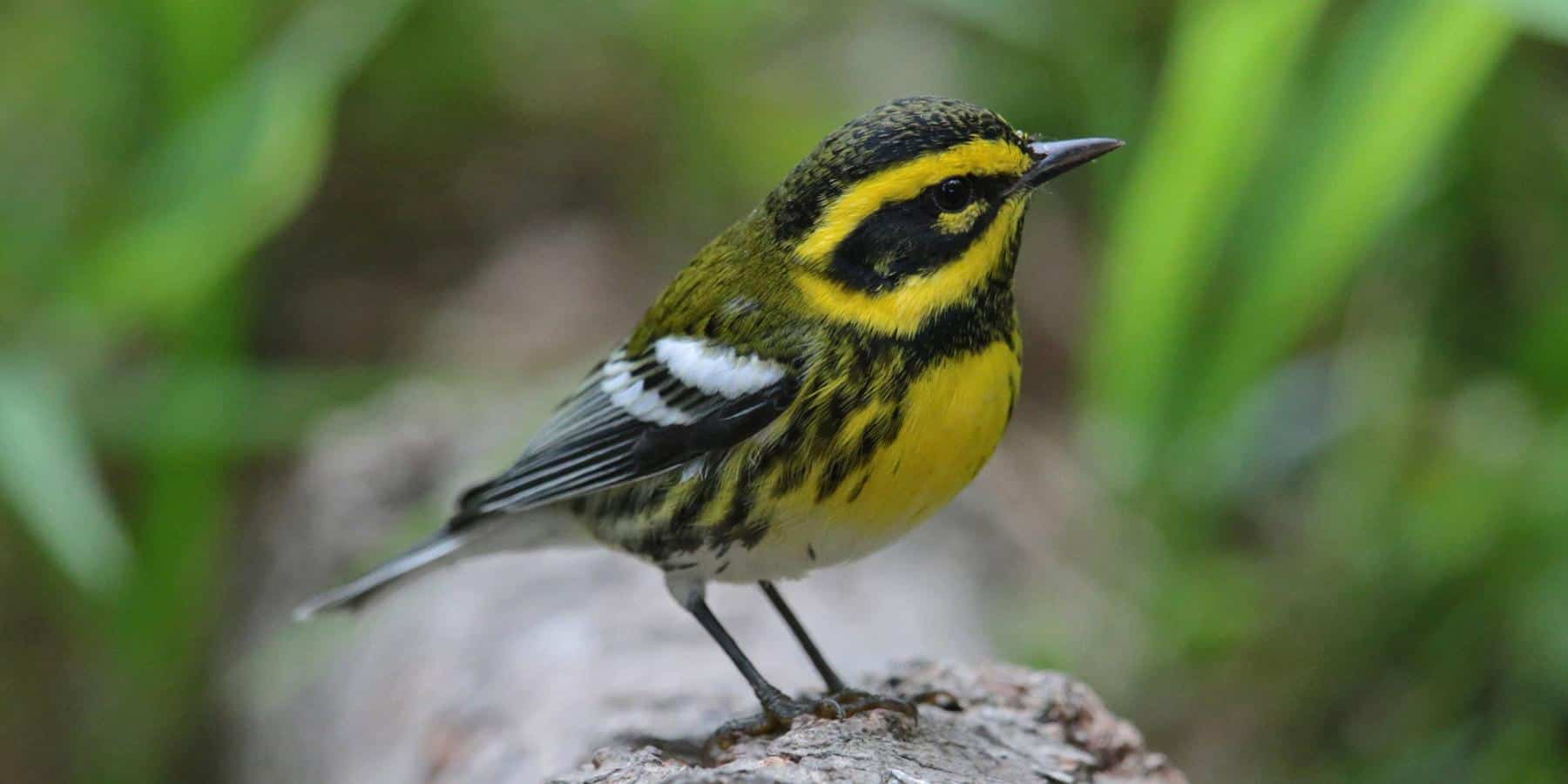
A small, energetic songbird with a striking yellow face marked by bold black streaks and an olive-green back. It’s around 5 inches long and is known for its constant flitting among branches.
- Region of Habitat: Breeds in coniferous forests of the Pacific Northwest, migrates to Mexico and Central America for winter.
- Scientific Name: Setophaga townsendi
- Feeding Habits: Insectivorous; gleans insects and spiders from needles and leaves, also eats berries during migration.
- What Sound They Make: Sings a high-pitched, buzzy song consisting of repeated “zee-zee-zee-bzz-bzz” notes.
Fun Facts
Townsend’s Warbler often hybridizes with the closely related Hermit Warbler. It’s named after American ornithologist John Kirk Townsend, who first documented the species.
11. Tricolored Heron
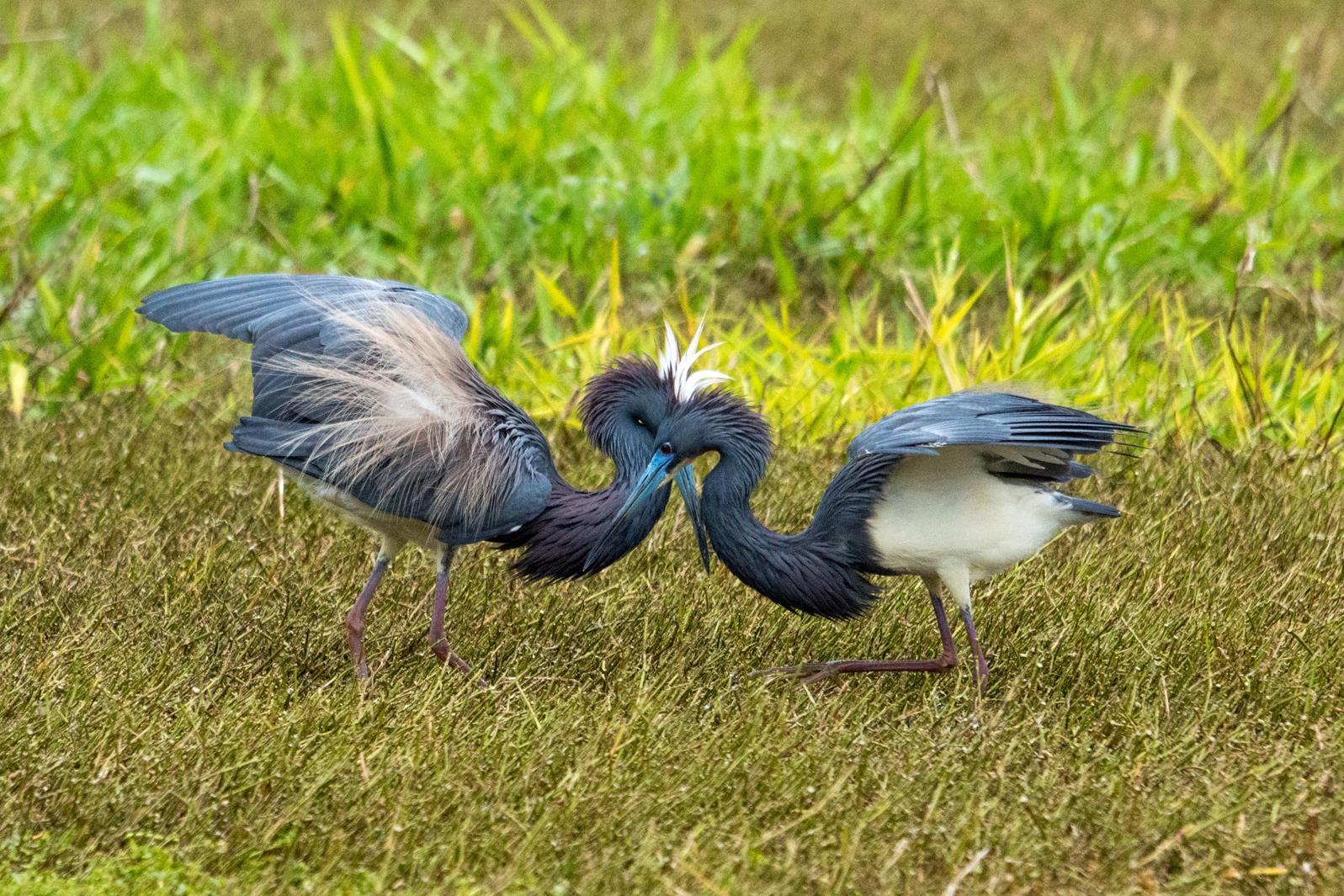
The Tricolored Heron is a slender, medium-sized wading bird with a long neck and legs, a dark blue-gray body, white belly, and rust-colored neck stripe. Adults measure about 26 inches in length with a wingspan of up to 37 inches.
- Region of Habitat: Found in coastal wetlands, marshes, and estuaries along the southeastern United States, the Caribbean, and Central and South America.
- Scientific Name: Egretta tricolor
- Feeding Habits: Carnivorous; feeds on fish, amphibians, and small crustaceans by stalking or running through shallow waters.
- What Sound They Make: They produce harsh croaks and clucks, mostly during courtship or when disturbed.
Fun Facts
Tricolored Herons are known for their dramatic feeding dances, including rapid dashes and wing-flaring to flush out prey. They’re solitary feeders and often compete aggressively with other wading birds.
12. Torrent Duck

The Torrent Duck is a streamlined, river-adapted duck with strong legs and a narrow body. Males have striking black and white plumage, while females are rust-colored. Both sexes have long tails and bills.
- Region of Habitat: Inhabits fast-flowing mountain rivers in the Andes of South America, from Colombia to Argentina.
- Scientific Name: Merganetta armata
- Feeding Habits: Insectivorous; feeds underwater on aquatic insect larvae, clinging to rocks with its claws.
- What Sound They Make: They emit soft whistles and chirping sounds, especially during flight or while interacting with mates.
Fun Facts
Torrent Ducks are expert swimmers and can dive and maneuver effortlessly in raging currents. They often nest in rock crevices near waterfalls and rapids, making them difficult to spot.
13. Tahiti Monarch
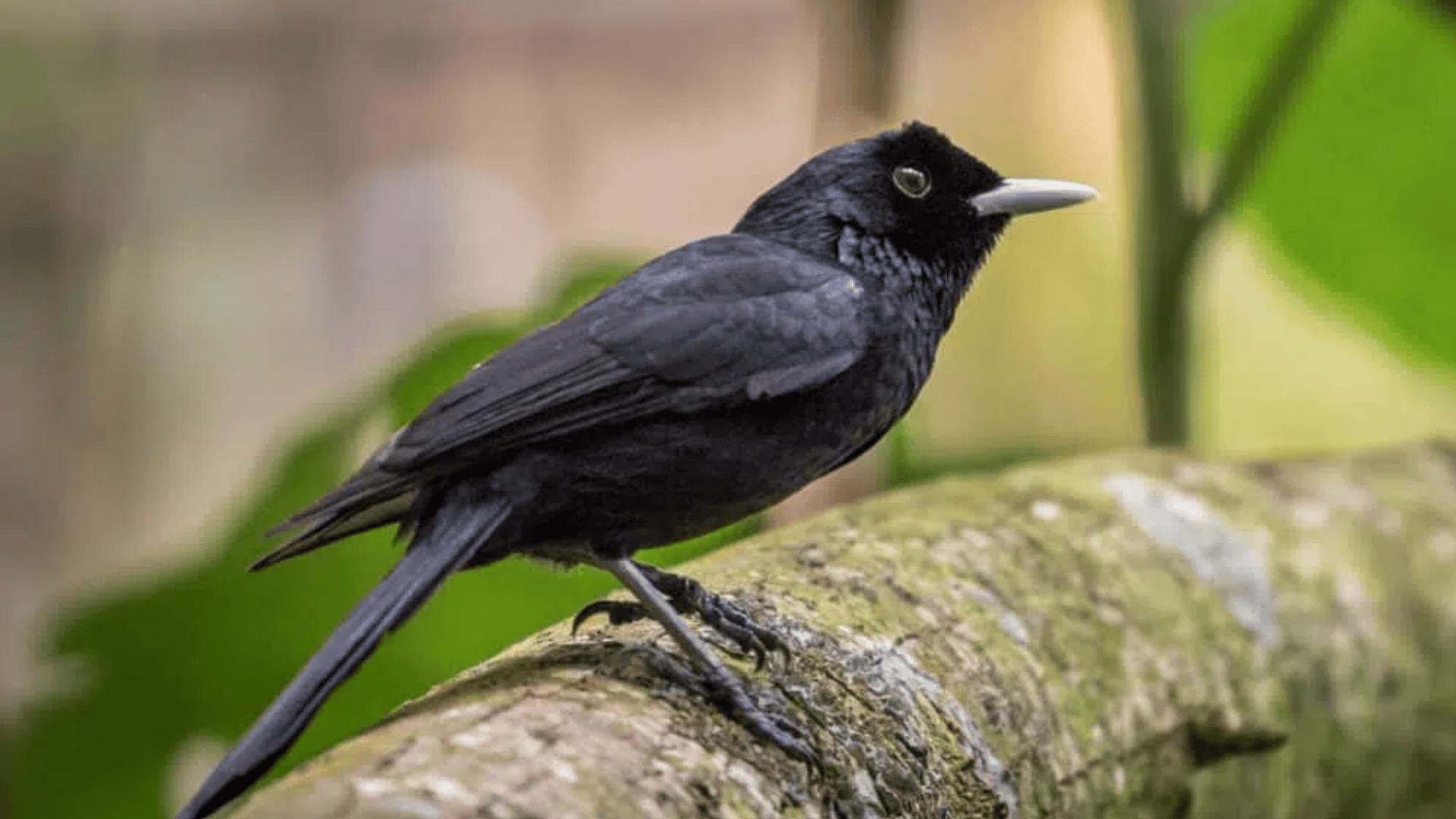
The Tahiti Monarch is a critically endangered bird with glossy black plumage, a short tail, and a slightly curved bill. It grows up to 6 inches long and has a slender, elegant posture.
- Region of Habitat: Endemic to Tahiti, found in the forested valleys of the island’s interior.
- Scientific Name: Pomarea nigra
- Feeding Habits: Insectivorous; feeds on insects and small invertebrates it finds on leaves and tree bark.
- What Sound They Make: They emit high-pitched whistles and soft trills used for communication among individuals.
Fun Facts
With fewer than 50 individuals remaining, the Tahiti Monarch is one of the world’s rarest birds. Introduced predators like rats and cats are major threats to its survival.
14. Tricolored Blackbird
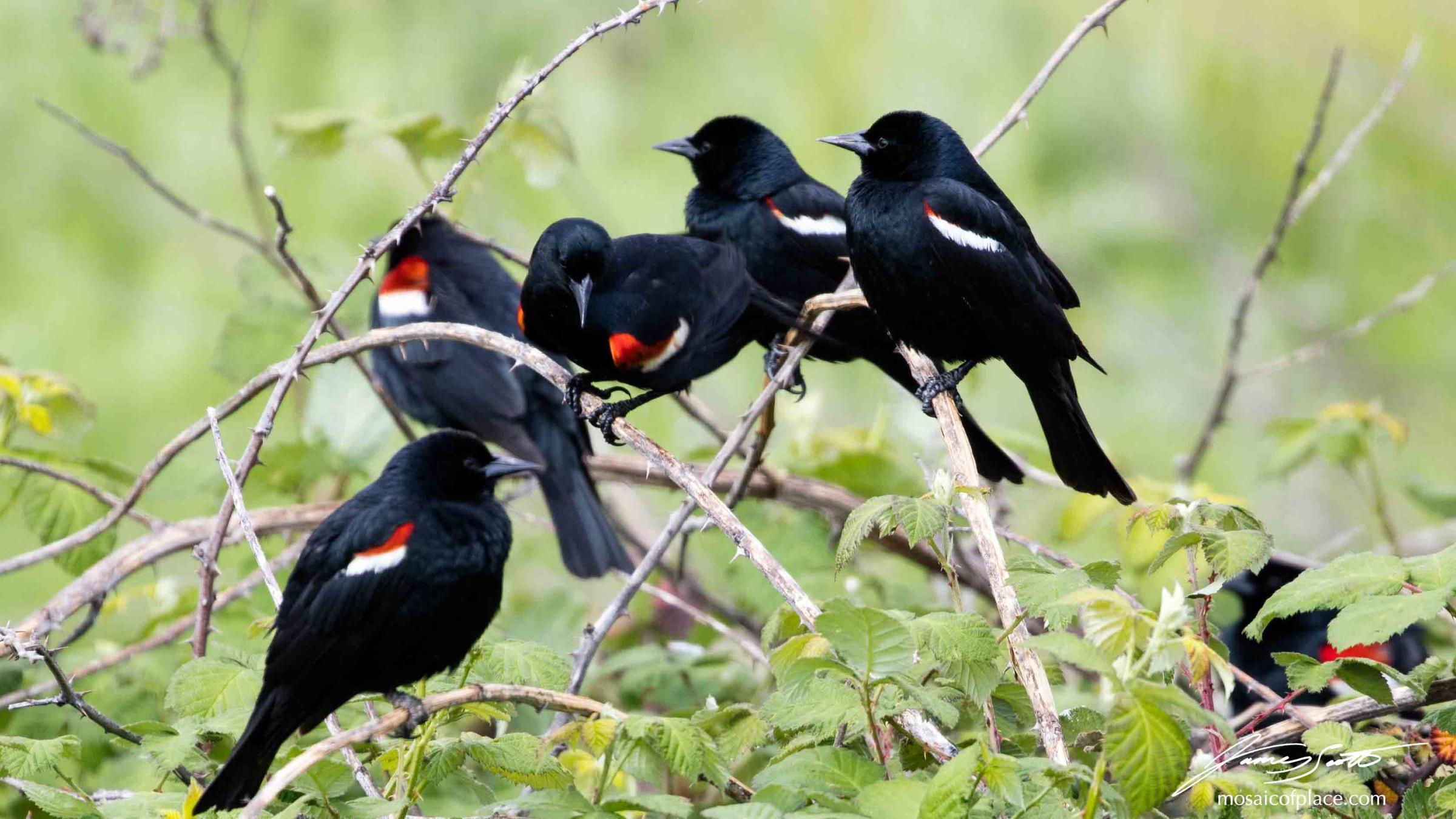
The Tricolored Blackbird is a medium-sized songbird with a black body and distinctive red shoulder patches bordered with white. It measures around 7 to 9 inches in length and resembles the Red-winged Blackbird.
- Region of Habitat: Found in wetlands and grasslands of California’s Central Valley, sometimes extending into Oregon and Baja California.
- Scientific Name: Agelaius tricolor
- Feeding Habits: Omnivorous; eats insects during breeding season and seeds, grains, and plants during migration.
- What Sound They Make: Produces a sharp, metallic “check” call and a whistled song during mating season.
Fun Facts
Tricolored Blackbirds are highly colonial, nesting in dense flocks of thousands. Their population has declined sharply due to habitat loss, placing them on several conservation watchlists.
15. Timor Green Pigeon
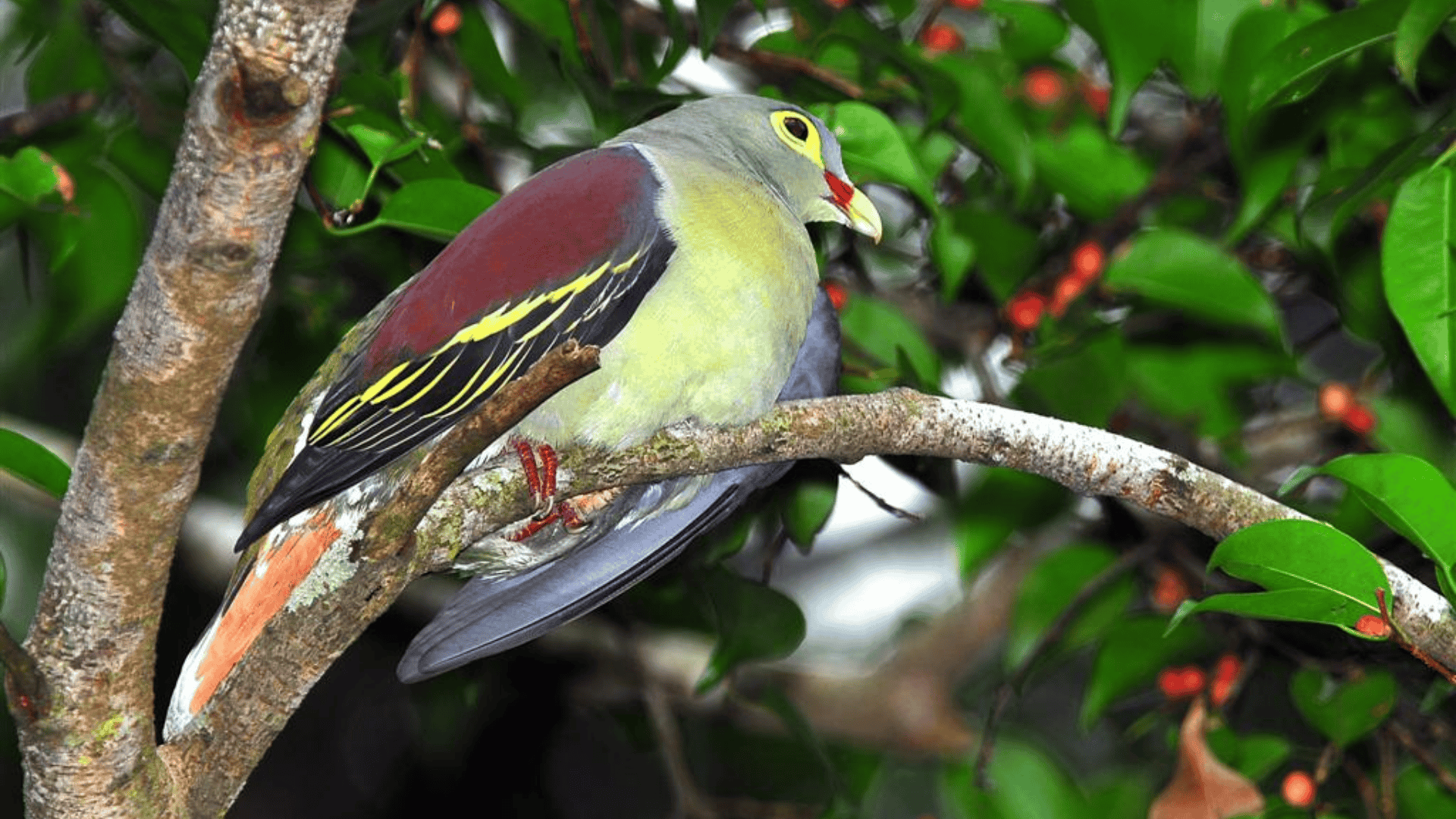
The Timor Green Pigeon is a medium-sized, fruit-eating bird with predominantly green plumage, a yellowish belly, and a gray head. It has a compact body, short tail, and soft appearance.
- Region of Habitat: Endemic to the island of Timor, found in lowland forests and foothills of Indonesia and East Timor.
- Scientific Name: Treron psittaceus
- Feeding Habits: Frugivorous; feeds mainly on figs and other tropical fruits high in tree canopies.
- What Sound They Make: They emit soft coos and bubbling calls typical of fruit doves.
Fun Facts
This species is very shy and hard to observe in the wild, contributing to its “Near Threatened” conservation status. Its camouflage makes it blend in almost perfectly with leafy trees.
More birds with the Letter “T”
16. Tibetan Snowcock
17. Tawny Fish Owl
18. Tufted Duck
19. Tawny Frogmouth
20. Tickell’s Blue Flycatcher
21. Tambourine Dove
22. Tawny-Flanked Prinia
23. Trilling Tapaculo
24. Tiny Hawk
25. Timor Sparrow
26. Tropical Parula
27. Ternlet
28. Tjeldsund Gull
29. Trumpeter Finch
30. Tawny Pipit
31. Texas Wren
32. Townsend’s Solitaire
33. Tinian Monarch
34. Tikell’s Leaf Warbler
35. Torrent Tyrannulet
36. Taiga Bean Goose
37. Tibetan Partridge
38. Traill’s Flycatcher
39. Tropical Gnatcatcher
40. Taiwan Barbet
41. Tiel Parrot
42. Torresian Kingfisher
43. Tikal Trogon
44. Tawny Tit-Spinetail
45. Tangara Tanager
46. Tufted Jay
47. Tiny Tyrant-Manakin
48. Thicket Tinamou
49. Tibetan Blackbird
50. Tithreebird
51. Thicket Antpitta
52. Tomtit
53. Taiwan Whistling Thrush
54. Taiwan Yuhina
55. Taiwan Fulvetta
56. Temminck’s Stint
57. Tchagra Shrike
58. Tipton Wren
59. Tawny-Shouldered Blackbird
60. Temminck’s Courser
61. Teco Tucan
62. Titlike Dacnis
63. Thrush Nightingale
64. Terek Sandpiper
65. Topknot Pigeon
66. Tamarin Grassbird
67. Tchitrec Paradise Flycatcher
68. Toktokkie Starling
69. Taiwan Bush Warbler
70. Trinidad Euphonia
71. Tokelau Rail
72. Thunderhead Parrot
73. Thrush-like Antpitta
74. Temminck’s Babbler
75. Tenasserim White-bellied Yuhina
76. Torresian Crow
77. Todirostrum Flycatcher
78. Tangier Lark
79. Tropical Boubou
80. Tirari Lark
81. Tibetan Lark
82. Taiwan Partridge
83. Tanimbar Corella
84. Togian Jungle-Flycatcher
85. Taiwan Fulvetta
86. Tawny-Headed Swallow
87. Taita Apalis
88. Tiny Greenbul
89. Timor Friarbird
90. Turquoise Parrot
91. Teardrop Tit
92. Tawny-Bellied Babbler
93. Tawny-Crowned Greenlet
94. Tawny-Crowned Pygmy Tyrant
95. Thick-Billed Vireo
96. Torii Lark
97. Twany Grassbird
98. Tonkin Parrotbill
99. Tonkean Myzomela
Final Insight
Witnessed the incredible diversity these feathered creatures bring to our planet. From the tropical habitats of toucans to the widespread territories of thrushes, these birds have adapted to thrive in countless environments across the globe.
Learning about their scientific classifications, unique diets, and distinctive calls, gaining a deeper appreciation for their ecological significance and evolutionary adaptations. Each “T” bird plays a vital role in maintaining nature’s flimsy balance.
If you’re an avid birder or casual nature enthusiast, these beautiful “T” birds will remind you of nature’s infinite creativity.
If you’re interested in more informative animal and wildlife content, feel free to click here and explore other blogs that you might enjoy!




